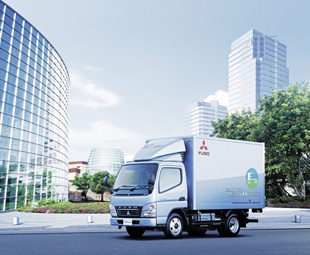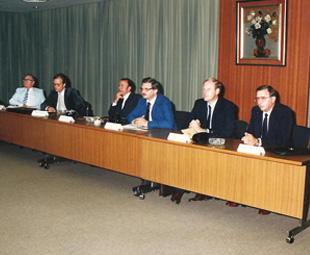A moment of nostalgia

The recent disastrous events in Japan moved FRANK BEETON into nostalgic mode and some thoughts on the world of yesteryear
The recent events surrounding the earthquakes and tsunami in Japan have focused intense global attention on that country. This has prompted me to write about my long professional involvement with Japanese trucks, which lasted from 1971 to 2000.
At some time or another during that period, I worked directly with all the Japanese brands present in the South African market, with the exception of Mitsubishi Fuso.
From the very first time that I looked at a Nissan Diesel product brochure back in 1971, I had a positive feeling about the Japanese way of putting a vehicle specification together. That doesn’t mean that selling Japanese trucks to conservative South African operators was easy. On the contrary, it took more than a decade before the brand gained a significant foothold in the local market, and even today, as a group that has transformed into UD Trucks, remains somewhat under-represented at the top end of the payload spectrum.
Much of the initial operator skepticism was down to “unconventional” specification choices. The early Nissan Diesels were powered by two-stroke engines, which generated high power outputs from small displacements, but were noisy and challenging to drive with unsynchronized transmissions, and had a tendency to convert their engine oil into sludge.
Hino and Isuzu persevered with indirect injection diesels long after all their Western competition had moved on to more efficient direct injection units. The replacement of pre-combustion chambers was a fairly frequent maintenance requirement with these vehicles.
With the passing of time, more acceptable specifications were introduced, and the popularity of Japanese trucks grew as their reputations for good value, reliability and efficiency were established. Innovation was still present, however; Isuzu’s high speed/low torque diesels fitted to its best-selling SBR and JCR cruiserweight models from the late 1970s were a case in point. With appropriate gearing, these engines produced class-leading performance and fuel economy, coupled with outstanding reliability.
A similar design philosophy utilised by Mitsubishi at that time resulted in these two brands threatening to dominate the middle reaches of the South African market as the 1980s dawned.
However, the South African government’s local content programme for trucks intervened shortly thereafter, and the Japanese brands were obliged to adopt Atlantis engines, and, in some cases, ASTAS transmissions, to stay in the market. These components were very different to the original equipment units they replaced, and considerable re-engineering of the vehicles, at great expense, was required. Although this process robbed the Japanese vehicles of their uniqueness, it did have the benefit of opening more conquest opportunities, particularly at the top end of the market, where the standardized driveline specification was seen by operators as a desirable attribute.
 As it turned out, Nissan Diesel and Hino gained traction during the ADE era, Isuzu elected to abandon the extra-heavy business, but consolidated its presence in the 4×2 categories, and Mitsubishi, after some less-than-optimal ADE engine selections, opted out of the market above the MCV category.
As it turned out, Nissan Diesel and Hino gained traction during the ADE era, Isuzu elected to abandon the extra-heavy business, but consolidated its presence in the 4×2 categories, and Mitsubishi, after some less-than-optimal ADE engine selections, opted out of the market above the MCV category.
Post-ADE, Nissan Diesel has become UD Trucks, and has enjoyed a successful run across all market segments, including the extra heavy category, where its compatriots are still seeking to improve market share. Hino has become the habitual runner-up in market ranking, taking on the mantle of the Toyota Group’s truck flagship brand. Mitsubishi Fuso came back as an important third brand in the Daimler Trucks family, and Isuzu re-entered the XHCV segment before launching a highly successful new line-up of MCV and HCV products.
From my own perspective, one of the most interesting aspects of this involvement was working closely with Japanese colleagues, and visiting their homeland.
My first trip to Japan was in 1985, when I co-hosted a media group to Isuzu and Suzuki. Because of its nature, this was very relaxed and we toured extensively, as well as visiting plants and Isuzu’s test track on Hokkaido. Highlights were visits to Kyoto and Hamamatsu, as well as two Shinkansen (Bullet Train) journeys, which meant that I was able to gain considerable insight into Japan’s culture and daily life.
Several trips made to Nissan Diesel in the 1990s were more business oriented, although there were numerous shorter excursions to spas and other cultural landmarks. As time progressed, I was taken increasingly into the confidence of my colleagues, and was invited to visit several of their homes. I even ventured solo onto Tokyo’s underground, which can be very daunting at rush hour. Those tales of white-gloved attendants pushing passengers into overcrowded carriages are not exaggerated!
Japanese business meetings have their own culture. Presentations are always conducted in Japanese, with the translation of questions and answers giving the hosts more time to think before responding. If there are 15 people in a meeting, at least two or three are usually asleep!
We also learnt not to expect immediate answers to “difficult” questions or requests.
Typical South African table-banging was inappropriate and totally ineffective, and, invariably, responses would eventually arrive late at night, well into a karaoke session or late in a meal of sashimi or tempura. I usually stayed in a hotel in the Ginza district of Tokyo, with the smallest rooms I have ever seen. However, I was happy to stay there because I was out most of the time, and I could enjoy a Western breakfast before embarking on a day of Japanese style eating, demanded by good manners. The truth is that I am not at all partial to raw fish, and haven’t eaten any since leaving Nissan in 2000!
This close involvement with Japan, its people and products left me with a deep respect for the culture, and I can only imagine how traumatic those recent events must have been for these honest, disciplined and dignified people. One can only hope that their equilibrium is restored soon.
Rear-view Focus is a column by FRANK BEETON that takes a nostalgic look at the truck and bus world of yesteryear. Visit www.focusontransport.co.za to comment on the column and share your memories with us.
Published by
Focus on Transport
focusmagsa



